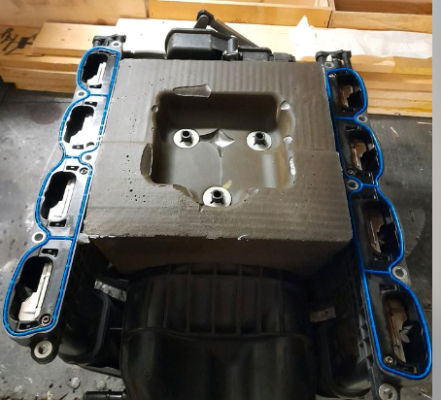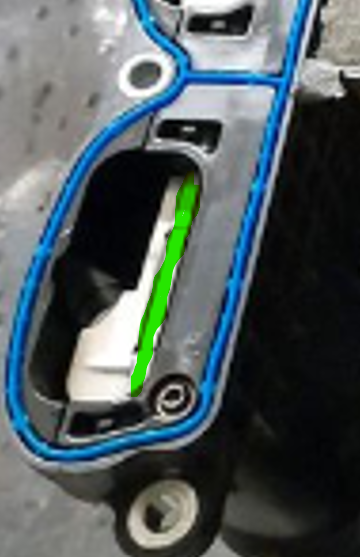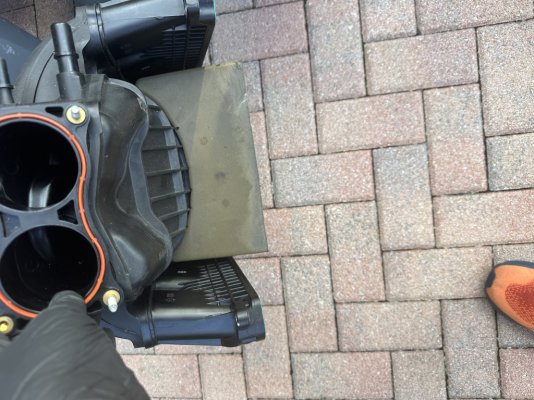You are using an out of date browser. It may not display this or other websites correctly.
You should upgrade or use an alternative browser.
You should upgrade or use an alternative browser.
Heat insulator below 2009 GT intake manifold?
- Thread starter GriffX
- Start date
Dino Dino Bambino
I have a red car
I can only see the insulation reducing heat soaking of the intake manifold plenum when the car is stationary or travelling up to 60km/h. At higher road speeds the IAT will be only slightly above ambient because the intake will suck in more fresh air rather than taking in hot air from the engine compartment, and this will also cool the IM plenum.
I would agree, the heat transfer engine -> plenum -> air, is on higher revs neglectable and insulation therefore also, but if Ford is doing this?
My Mercedes changes ignition angle above 36°C IAT, measured at the MAF. If there is an effect in the engine V, lets say 1 or 2°C increase, the tune must know this because the IAT is measured at the MAF sensor.
An other thing I noticed, the charge motion valves doesn't have the valve shaft in the middle of the channel (?) anymore, so no benefit from a delete?
My Mercedes changes ignition angle above 36°C IAT, measured at the MAF. If there is an effect in the engine V, lets say 1 or 2°C increase, the tune must know this because the IAT is measured at the MAF sensor.
An other thing I noticed, the charge motion valves doesn't have the valve shaft in the middle of the channel (?) anymore, so no benefit from a delete?
An other thing I noticed, the charge motion valves doesn't have the valve shaft in the middle of the channel (?) anymore, so no benefit from a delete?
Well getting rid of the valves will open up the manifold. So there is no center shaft to open and close the valves? So do they stay closed or open? They looked closed in the photo. If they don't move then I would definitely delete them. But what I'm a little confused about is if you remove the center shaft, then what is holding the valves???
AHaze
Member
Pretty sure it's just the angle of the photo that makes it look like the shaft is out of the airflow when open. I don't think theres any functional difference between this later 1 piece manifold and the early one with the separate CMCV housings. The '09s with this manifold had the same HP rating as the '05-'08s and the power bump on the '10s was due to using the Bullitt CAI and tune.
As for the foam, I'm wondering if it's purpose is more sound deadening than heat insulation?
The Coyotes that had CMCVs got the shaft pretty much completely out of the airflow so Ford did learn eventually.
As for the foam, I'm wondering if it's purpose is more sound deadening than heat insulation?
The Coyotes that had CMCVs got the shaft pretty much completely out of the airflow so Ford did learn eventually.
This is the intake manifold from a late 2009 model, so it is likely the 2010 intakeI thought 2010 had a different intake?
You are probably right. I didn't know that the 2010 had a Bullitt CAI.Pretty sure it's just the angle of the photo that makes it look like the shaft is out of the airflow when open. I don't think theres any functional difference between this later 1 piece manifold and the early one with the separate CMCV housings. The '09s with this manifold had the same HP rating as the '05-'08s and the power bump on the '10s was due to using the Bullitt CAI and tune.
As for the foam, I'm wondering if it's purpose is more sound deadening than heat insulation?
The Coyotes that had CMCVs got the shaft pretty much completely out of the airflow so Ford did learn eventually.
Found a 2nd picture from the back. The insulation is up to the runner. Maybe it is heat and sound insulation?
If it is heat related, cyl 4/8 will get warmer air than 1/5, contact time air to intake is longer.
My car is in winter storage, otherwise I would try to measure the intake runner temps, ok, next year.....
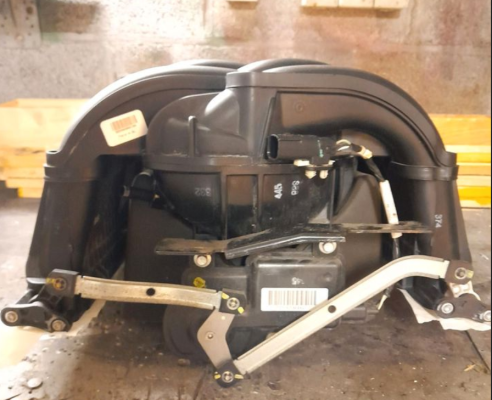
Yeah that looks like a 2010 one piece intake which has integrated motion charge valves.
I don’t think the intake is the same as Bullitt. Bullitt has an open element and the 2010 GT has a closed air box. As for the tuning… I have no idea if it’s different?
I don’t think the intake is the same as Bullitt. Bullitt has an open element and the 2010 GT has a closed air box. As for the tuning… I have no idea if it’s different?
Dino Dino Bambino
I have a red car
Yeah that looks like a 2010 one piece intake which has integrated motion charge valves.
I don’t think the intake is the same as Bullitt. Bullitt has an open element and the 2010 GT has a closed air box. As for the tuning… I have no idea if it’s different?
The air intakes on the 2010 GT and the '08-'09 Bullitt were different but both were factory rated at 315hp/325lbft. On a chassis Dyno, they typically put down high 270s rwhp & mid 290s rwtq so I reckon the factory slightly underrated them (perhaps 320hp & 335lbft was more realistic).
The '09-'10 intake manifolds had integrated charge motion control valves whereas the assemblies were separate on the '05-'08. Steeda used to sell delete plugs for the '09-'10 models but unfortunately they've been discontinued.
AHaze
Member
My bad... rusty memory, I guess. Thought the '10s used the Bullitt intake but it looks like they actually shared an air box with the '11+ Coyote cars.
GlassTop09
Senior Member
This picture is of a Ford OEM replacement IM that Ford had made later on to replace any of the 05-10 IM's. They used the 09-10 IM design to make this & Ford did offset the CMCV shafts towards the inner IM port walls to make more room in the IM runner porting to improve high RPM airflow performance while still providing the low RPM port velocity increase thru closing the CMCV's to promote better A\F & EGR mixing in the cylinders during the intake stroke. Ford also installed the plenum insulation to offset plenum heat soak to promote better air charge cooling.You are probably right. I didn't know that the 2010 had a Bullitt CAI.
Found a 2nd picture from the back. The insulation is up to the runner. Maybe it is heat and sound insulation?
If it is heat related, cyl 4/8 will get warmer air than 1/5, contact time air to intake is longer.
My car is in winter storage, otherwise I would try to measure the intake runner temps, ok, next year.....
View attachment 91967
Here provided below are a couple pictures of my '09 Ford OEM IM (same integrated CMCV design) that came off my Stang when I replaced it w\ a FRPP IM back in April 2018........you'll note that there is no plenum insulation installed under it & the CMCV shafts are still in center of the IM runners (you can't see em but they're in the center of the IM runners).
I've since replaced the FRPP IM w\ an '08 OEM IM w\ the removeable CMCV's & replaced them w\ a set of Steeda CMDP's & have disposed of my original '09 OEM IM after removing the CMCV actuator, engine harness bracket & wiring pigtail (am currently using all this on my '08 OEM IM to turn on the IMRC switches & set all the IMRC opening settings to 1.10 load in tune calibration so the actuator stays parked at the IMRC closed position thus the ECU will use all IMRC Closed maps only--Ford default CMCV position & all this coding does is to instruct the ECU when to switch from using the IMRC Closed maps to the IMRC Open maps & vice versa based off engine RPM & engine load% to coincide w\ CMCV open\close operation--so all is set up in tune as OEM so when a DAD is plugged into the OBDII port, it sees that the tune calibration appears untouched--all tune calibration switches\DTC coding as set up from factory--even though the checksum that determines the OEM tune calibration Cal\CVN number range may be different--CMCV's aren't a requirement for IM Readiness emissions testing\monitoring, only operational DTC monitoring......also to reattach the engine harness back on the bracket & get it off the back side of the engine block\trans housing).
Posted this to show that this IM that GriffX is showing was not originally installed from factory but was Ford-made as an OEM replacement part to any factory installed 05-10 OEM 4.6L IM.
Hope this helps.
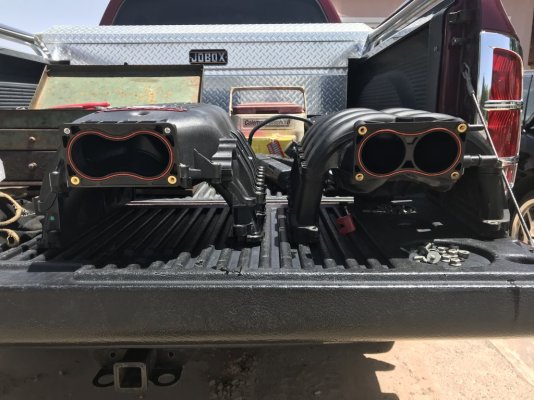
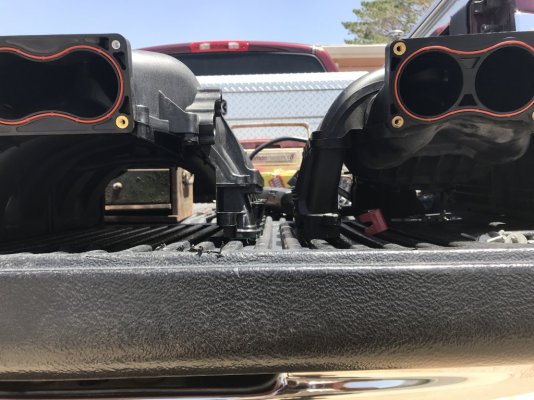
GlassTop09
Senior Member
Did you get all the mounting bolts w\ it? I mention this as the mounting bolts that fit that IM are a different length than those for a 05-08 OEM IM (09-10 OEM IM uses M6 x 50mm bolts vs 05-08 OEM IM uses M6 x 62.5mm bolts.........).......if your intention was to install it on your 05 Stang.All I know is that the intake is from a late 09 salvage car, according to the seller, so origin not clear.
But thank you for clarification!
Have not decided to buy it so far. I removed the valves on my OEM intake and car runs good with tune, but the fuel consumption is going up a bit. Fuel will pass 8$/gal next year (another tax increase) so I was looking for other options and found this for me unusual looking intake. I guess it needs changes in the tune too?Did you get all the mounting bolts w\ it? I mention this as the mounting bolts that fit that IM are a different length than those for a 05-08 OEM IM (09-10 OEM IM uses M6 x 50mm bolts vs 05-08 OEM IM uses M6 x 62.5mm bolts.........).......if your intention was to install it on your 05 Stang.
I'm driving 90% of the time <3000rpm, not sure if the fuel consumption will go down with the valves.
Thanks for the information about the bolts. They are not included.
If I understand you correctly:
1. This is not the OEM 09-10 intake
2. It was an Ford replacement intake with flow optimized valves (2010 style), heat shield
3. It needs shorter bolts
4. It needs re-calibrated fuel maps
Thanks!
My bad... rusty memory, I guess. Thought the '10s used the Bullitt intake but it looks like they actually shared an air box with the '11+ Coyote cars.
The oem airbox on the 2010 GT flows a lot more air than the 11-12 GT oem airbox....and both the 2010 and the 11-12 airbox's flow even more air with the K+N panel filter.
Once I replaced the oem upper grille on the 2010GT, with the 7 bar upper grille (which also deleted the oem foglamps), that eliminated the 2 x 90 deg bends. Now it's air straight into the 'snorkel' that feeds air into the oem 2010 GT airbox. The problem with the oem upper grille on the 10-12 cars is...... they are 80% blocked off. The air has to go in and do a 90 deg bend..then a 2nd 90 deg bend to even get to the 'snorkel'. With the stock oem 10-12 upper grille, you can't even see the snorkel. With the 7 bar upper grille, the air just screams in. The HE on the 2010 M90 PD blower setup is the same as the bigger Roush TVS-2300 blowers....... they are 18" tall x 21" wide. The HE now gets hit with air from both the upper + lower grille
I have a 2010 GT auto.... but with a Roush M90 PD blower..... so the oem IM was tossed. The new Roush IM is aluminum.
GlassTop09
Senior Member
1. CorrectHave not decided to buy it so far. I removed the valves on my OEM intake and car runs good with tune, but the fuel consumption is going up a bit. Fuel will pass 8$/gal next year (another tax increase) so I was looking for other options and found this for me unusual looking intake. I guess it needs changes in the tune too?
I'm driving 90% of the time <3000rpm, not sure if the fuel consumption will go down with the valves.
Thanks for the information about the bolts. They are not included.
If I understand you correctly:
1. This is not the OEM 09-10 intake
2. It was an Ford replacement intake with flow optimized valves (2010 style), heat shield
3. It needs shorter bolts
4. It needs re-calibrated fuel maps
Thanks!
2. Correct......you see Ford also recognized the issues w\ the original OEM design & made corrections to the OEM replacement part to offset these issues. The whole purpose for the CMCV's is to increase the intake air charge port velocity when closed at low engine RPMs to enhance the A\F atomization\mixing w\ the intended EGR backflow to create a better, complete fuel burn which will increase the low RPM TQ output potential due to increased engine operating efficiency. The offset of the CMCV shafts is intended to correct the high RPM airmass flow restrictions by opening up more of the IM runner port area by moving the CMCV plates towards the inner section of the IM runners where the air flow is much less disturbed when the CMCV's are opened fully........just as you see Ford designing the CMCV's in all '15 MY & later Coyote\Coyote variants IM's......just did a much better job of designing these vs the earlier Mod Motor designs. The heat shield was another change to help gain a cooler air charge by reducing the IM plenum heat soak potential from radiant heat rising up from engine cyl heads\block\heater hose manifold. This was later dropped entirely & why you see no Coyote\Coyote variant IM adopting this heat shield as Ford found this to be of no viable use due to the 2010 MY OEM CAI design (that is still being used on all OEM MY Coyotes\Coyote variants to this day) that virtually eliminated this issue.
3. Correct. Remember, I've already crossed this road as I've installed a 05-08 OEM IM on my '09 GT 4.6L..........the OEM Ford M6 IM bolts for either IM are expensive to get from Ford (come only in a 4-pack so you'd need to buy 3 of them so you'd have 2 extra bolts) or pick up some from a hardware store (guarantee this is the cheaper route to go).
4. Technically no it doesn't. It needs the IMRC reenabled in the tune calibration then all the IMRC Closed\Open maps restored to at least the OEM settings (all these settings relate to either airmass flow control offsets in SD operation--LWFM, SD MAP at Zero Airmass, MAP per Airmass; VCT airload cam retard timing control & Spark Advance BKT\MBT VCT multi adder correction timing maps along w\ Spark Advance BKT\MBT IMRC Open spark advance timing correction maps) which, if you're still using the OEM 55mm TB & its in-tune PTA\EA map settings & the OEM CAI's MAF calibration & LWFM airmass maps along w\ the OEM cams, this is practically a plug-n-play operation.......but if you're using a non-OEM CAI that had to have the MAF & LWFM airmass maps (or any of the other items mentioned above) recalibrated\removed\disabled then yes you'd need to get all retuned to properly use this IM.
So, this kinda depends on the particular criteria at hand to determine direction from my POV............................
So, unless a tuner really understands all this to retune for this IM, the best approach IMHO is return EVERYTHING back to stock so all will match back up component-wise to tune-wise.............if you really want to use it. Then retune for each component that is changed from stock to keep all in line & relevant thruout the tune calibration.
My 2 cents.......................
Hope this helps.
Last edited:
GlassTop09
Senior Member
True that.....................why I have 1 in my possession to retrofit into my '09 GT at some point in the future. All is a straightforward swap.......but the AC condenser line needs to be changed to the 2010 MY part to clear the area beside the DS of radiator for the snorkel to protrude thru, the PS reservoir engine mounting bracket is needed to move the PS reservoir to clear the CAI tube (or move the PS reservoir to the PS of radiator by the WW reservoir like you'd do for a centri FI install or convert the hydraulic PS rack to EPAS) & repin the existing MAF wires to fit in the 2010 MY CAI MAF extension harness connector.The oem airbox on the 2010 GT flows a lot more air than the 11-12 GT oem airbox....and both the 2010 and the 11-12 airbox's flow even more air with the K+N panel filter.
Not in any hurry for now as the Ford 08-09 OEM Bullitt 83mm CAI is another very capable performing unit that can rival a JLT Series 3 CAI in performance practically across the board, especially when equipped w\ the K+N E-1997 OEM replacement cone filter..........also is a LEGAL EPA part as well paired on a SBE 4.6L V8 (Bullitt 4.6L engines are identical to a GT 4.6L engine in every aspect........the differences are in the CAI, ECU OS\tune calibration & exhaust tuning).
This '10 OEM CAI design using a K+N panel filter is easily THE BEST performing\flowing CAI design for the 4.6L 3V V8 NA engine hands down.........also is fully EPA LEGAL as well mounted on any 05-10 GT as all GT 4.6L engines are EPA rated the same VEI classification..........is easily a plug-n-play setup tune-wise as well due to the methods Ford used in tuning all 05-10 S197 4.6L V8 engines if tune is left mostly in OEM stock setup\configuration.
86GT351
forum member
Similar threads
- Replies
- 9
- Views
- 351
- Replies
- 3
- Views
- 138
- Replies
- 3
- Views
- 676
- Replies
- 10
- Views
- 411
Support us!
Support Us - Become A Supporting Member Today!
Click Here For Details


